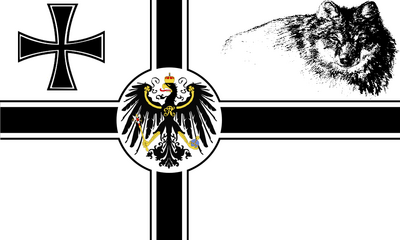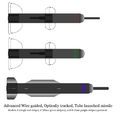Imperial Army of TECT
| The Imperial Army of TECT | |
|---|---|
 Logo of the Imperial Army. | |
| Active | 1500BCE – Present |
| Country | |
| Allegiance | TECT |
| Type | Army, Combined Arms |
| Size | 9,000,000 |
| Part of | TECT Armed Forces |
| Garrison/HQ | Fort Maximus |
| Nickname(s) | Empire's Army, Block Heads, Wolves of TECT, IA |
| Patron | Emperor Maximus Forelis |
| Motto(s) | "Honor and Strength Under Unity." |
| Colors | Black, White, and Gold |
| Mascot(s) | The Wolf |
| Commanders | |
| Secretary. | Royle Waller. |
| Vice Secretary. | Hubert Randall. |
| Chief Officer of The Army. | GEN Clifford King. |
The Imperial Army of TECT or Imperial Army (IA), is the branch of the TECT Armed Forces that is responsible for land based military operations and is one of the oldest military forces in The Empire of Common Territories. The Imperial Army has a long and proud history in serving the Empire throughout history since its conception in 1,500BCE; it first served as the Grand Army of both Maximus Forelis and Antony Forelis and would later become the nation's army. Today with 9,000,000 in service, the IA is as elite as it is large of a military branch; today's Imperial Army focuses on hard work ethics, responsibility, elitism, training, and knowledge.
The Imperial Army is tasked with fighting the Empire's enemies and defending its territory on land as well as being a workhorse for the military. The IA provides the majority of the military's ground forces for military operations; it also provides aid to other branches and construction of most military facilities for other branches in the military. The Imperial Army is home to many branches that are organized at a Divisional level, including 'Armored', 'Engineers', 'Infantry', 'Artillery', and various others. Today; the Imperial Army is still a formidable military force with a large and state-of-the-art service force and is a very valuable member of the TECT Armed Forces.
Organization
The Imperial Army, like other military branches, utilize the Division structure; this unit is comprised usually of ten to fifteen thousand men. Only during special circumstances - like during war - can military units be organized under larger or even smaller structures (Corps. and Regiments for example. A Major General is usually the commanding officer of any Division while Colonels make up secondary commanders, Regimental commanders, and sometimes vice-commanders. As of 2015, the TECT Imperial Army has a diverse array of Divisions in its forces - the vast majority of them, however, are Armored, Mechanized, and Airborne. Infantry used to be the mainstay of IA forces until the importance of armored and mechanized forces became clear during the 20th century; as of now there are few Infantry Divisions, all of which focus primarily on difficult terrain/mountain warfare.
Each Division focuses on a certain mission set or equipment center point. Armored, for example, focuses on anti-armor with a general mix of anti-everything else using more armored vehicles - these includes tanks, heavy and regular armored personnel carriers, self-propelled artillery, and infantry fighting vehicles more commonly over APCs. During the 18th century, the Cavalry Division was the mainstay that would be later replaced with armored forces - these troops primarily used horses and dragoons in combat. Mechanized Divisions focus on infantry troops with armored support, such as APCs or IFVs; depending on the Division, some use lighter vehicles, heavy vehicles, and some utilize tanks even. The Mechanized Division replaces standard Infantry Divisions since Mechanized troops are similar but feature armored vehicles that support them. Airborne Divisions are a more recent organization that utilizes helicopters, infantry, and lighter vehicles as part of its mission. Airborne soldiers are supported, transported, and work alongside helicopters and other aircraft for combat; they are light, highly mobile, and can be multi-mission too.
While Divisions have their set types, smaller units that make up battalions and regiments can have set missions of their own. For example, anti-air battalions or engineer battalions serve special missions while infantry regiments serve a various amount. Companies are also a possible force size for smaller units.
Ranks and Layout
| TECT Pay Grade | E-1 | E-2 | E-3 | E-4 | E-5 | E-6 | E-7 | E-8 | E-9 | ||||
|---|---|---|---|---|---|---|---|---|---|---|---|---|---|
| Insignia | No Insignia | ||||||||||||
| Title | Private | Private | Private First Class | Specialist | Corporal | Sergeant | Staff Sergeant | Sergeant First Class | Master Sergeant | First Sergeant | Sergeant Major | Command Sergeant Major | Imperial Sergeant of the Army |
| Abbreviation | PVT | PV2 | PFC | SPC ² | CPL | SGT | SSG | SFC | MSG | 1SG | SGM | CSM | SMA |
| TECT CENTCOM Code | OR-1 | OR-2 | OR-3 | OR-4 | OR-4 | OR-5 | OR-6 | OR-7 | OR-8 | OR-8 | OR-9 | OR-9 | OR-9 |
| ² SP4 is no longer an acceptable abbreviation for Specialist. | |||||||||||||
| TECT Officers Pay Grade | O-1 | O-2 | O-3 | O-4 | O-5 | O-6 | O-7 | O-8 | O-9 | O-10 | Special |
|---|---|---|---|---|---|---|---|---|---|---|---|
| Insignia | |||||||||||
| Title | Second Lieutenant |
First Lieutenant |
Captain | Major | Lieutenant Colonel |
Colonel | Brigadier General |
Major General |
Lieutenant General |
General | Imperial General of the Army |
| Abbreviation | 2LT | 1LT | CPT | MAJ | LTC | COL | BG | MG | LTG | GEN | GA |
| TECT CENTCOM Code | OF-1 | OF-2 | OF-3 | OF-4 | OF-5 | OF-6 | OF-7 | OF-8 | OF-9 | OF-10 | |
Equipment
AR Scorpion is the main weapon of the TECT Armed Forces and the Imperial Army.
AR Fortgeschritten bullpup assault rifle.
Mark-7 Kanone Service Pistol.
SM Stinger sub-machine gun/personal defense weapon.
LSW Mare squad automatic rifle and light machine gun.
- SMJ-Truck Mount.jpg
SMJ 14.5 mm Heavy Machine Gun family Info.
- SMJ-Gatling Series Test Model.jpg
SMJ 14.5 Gatling Series family Info.
Fang Sniper System, semi-automatic sniper rifle.
ASG Hirsch automatic shotgun.
MK-19 automatic grenade launcher. Info.
- Panzerfaust-11V2.png
AMR Sturm anti-material sniper rifle.
Tank(s)
- Feurig 1V4.png
Feurig 1A2 (Reserve/Stock). Info.
- Feurig 2A1 V2.png
The Feurig 2A1 MBT (Reserve/Stock or Updated). Info.
- Feurig 2A2 MBT V4.png
Feurig 2A2 (Primary). Info.
- T-62F V3 A4 Lineup.png
T-62F Medium Battle Tank. Info.
- Schwert LBT B6.png
Schwert Light Battle Tank. Info.
Armored Personal Carriers & Armored Fighting Vehicles
- Schildkröte AAV-V2A-Product page.png
The Schildkröte AAV/APC. Info.
- Puma Wheeled APC V3-Base.png
Puma Wheeled APC/AFV Series. Info.
- Hollendhun-SidebySide-V2-A2.png
Höllenhund Infantry Fighting Vehicle. Info.
- Bar Product Picture-V2.png
Bär Heavy APC Series. Info.
Other Armored Vehicles
- Fuchs SLAV V3 C3.png
The Fuchs Scout/Light Armored Vehicle. Info.
The Schroder Gun Truck Mk.2 Series. Info.
- Luchs PMV.jpg
Luchs Protected Mobility Vehicle. Info.
Engineer/Support Vehicles
- Entlein CERV.png
Entlein Combat Engineering and Recovery Vehicle. Info.
- Ente Amphibiouse Cargo Truck (Bare Bed)C.png
Ente Amphibious Transport Series. Info.
- Wolverine V2 Combat & Standard Suits.png
Wolverine All Terrain Transport. Info.
Artillery Pieces
- Longbow Howitzer V2A2.png
Longbow Towed Howitzer. Info.
- Mk. 125 'Crossbow' B1A3 Comparison.png
Crossbow Lightweight Towed Howitzer. Info.
- HMS-15 Armbrust.png
- LMS-14 Schlinge B6.png
- SpeerWurf SPH V2B1.png
SpeerWurf Self-Propelled Howitzer. Info.
- Boar SPH V2.png
Boar Self-Propelled Howitzer. Info.
- MRLS mk.2.png
Heiliger Blitz multi-role MRLS. Info.
- Panther Flakpanzer V2.png
Panther Flakpanzer SPAAG. Info.
Airborne Equipment
- Kondor Mulitrole Helicopter V2C2.png
The Kondor Utility Helicopter. Info.
- HLT Adler Helicopter V2C3.png
The HLT Adler Helicopter. Info.
- Anakonda Attack Helicopter V2C4.png
The Anakonda attack helicopter. Info.
- GAP Dragon.jpg
Ground Attack Plane Dragon. Info.
Ordinances
'Faerber' Series of Ammunition.
'Speer' Anti-Tank Guided Missile family. Info.
ALOT ATGM Series. Info.
- Slingshot SAM.jpg
Slingshot "New Age" Surface-to-Air Missile family. Info.
- M118 'Pfeil' Rocket Series.png
'Pfeil' 120/220 Rocket Artillery Series. Info.
- TRS 'Fromme Faust' Rocket Series.png
'Fromme Faust Artillery Rocket Series. Info.
- M666 GLATGM.png
M666 GLATGM. Info.
- M225 Artillery Shell.png
M225 Artillery Shell. Info.
- M290 Tank Shell.png
M290 Tank Shell. Info.
- M291 Tank Shell.png
M291 Tank Shell. Info.
- Image unavailable
M230 Tank Shell. Canister shot tank shell; no further info available.
- M299 Tank Shell.png
M299 Tank Shell. Info.
- SSM-7 Comparison.png
SSM-7 Mk. 1 & 2 'Mary Sue & Blue' (B model) ASM. Info.
- Lanze LRSAM E1.png
Lanze Long Range Surface-to-Air Missile System. Info.
- Komet Side-By-Side 2.png
Komet BVRAAM (A and GLAAM models). Info.
- Spatz Autonomous Smart Submunition.png
Spatz Autonomous Smart Submunition (SASS). Info.








